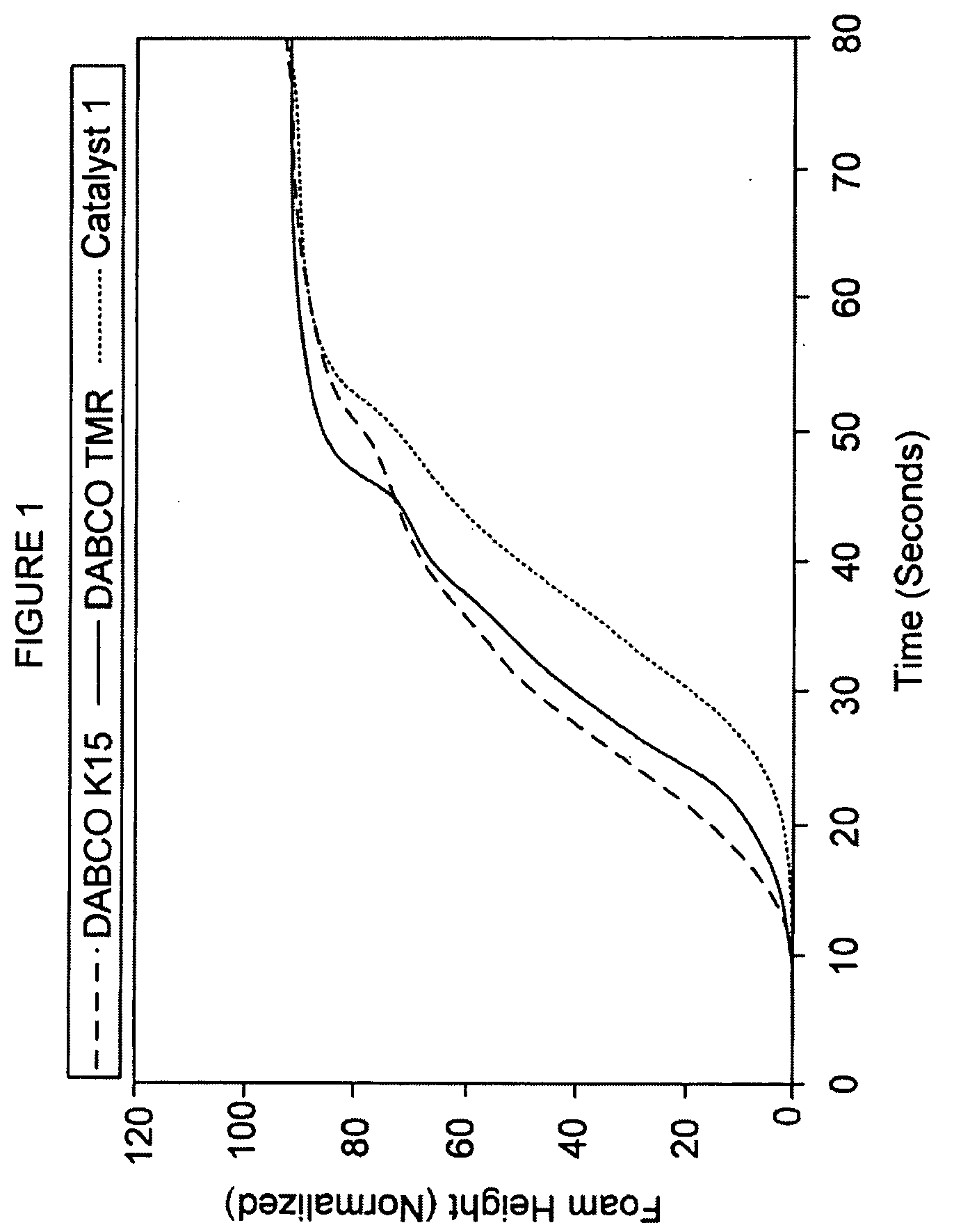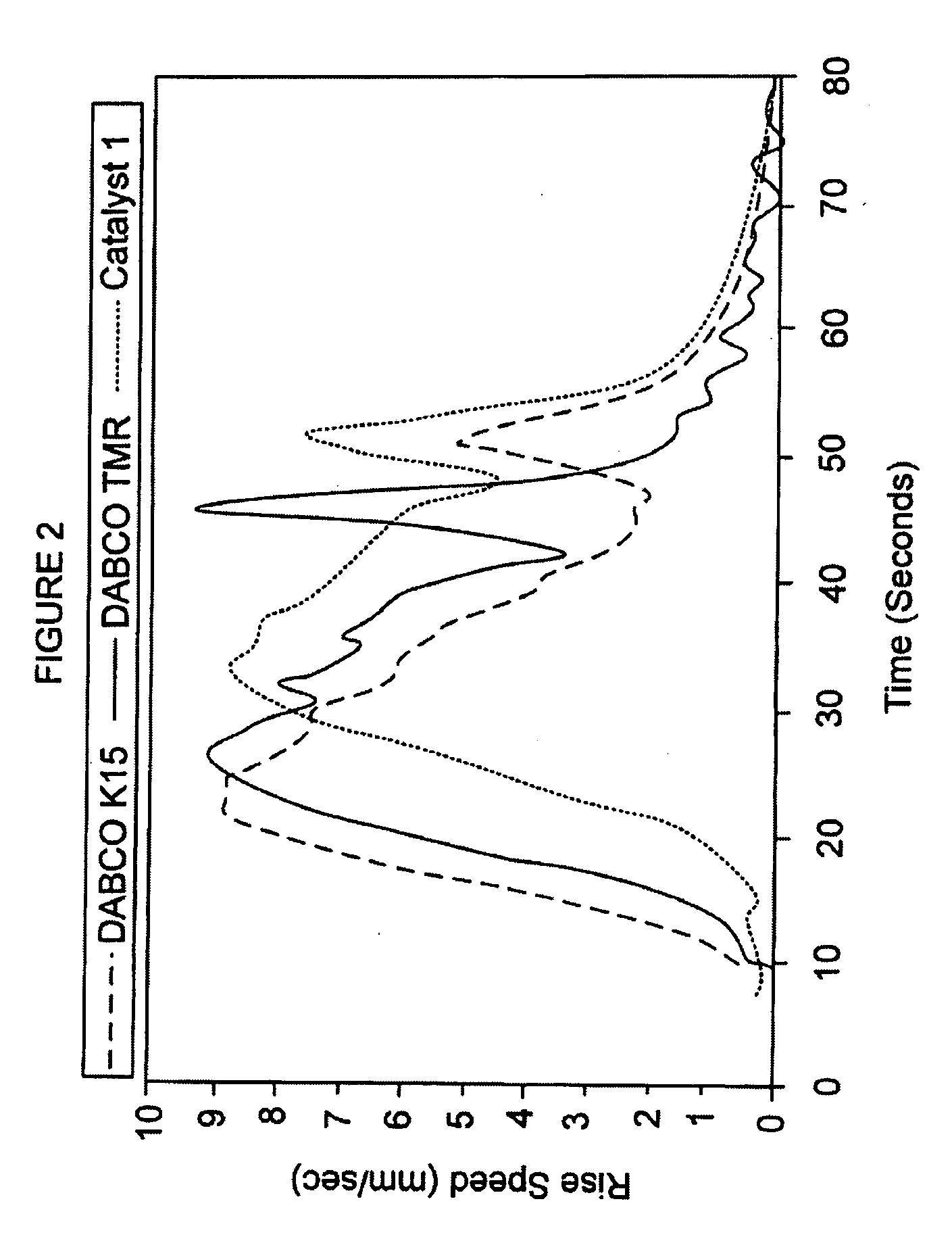Stabilized carbanions as trimerization catalysts
- Summary
- Abstract
- Description
- Claims
- Application Information
AI Technical Summary
Benefits of technology
Problems solved by technology
Method used
Image
Examples
##ventive example 1
Inventive Example 1
Comparison of a Tetramethylammonium Acetylacetonate Catalyst with Standard Catalysts at an Isocyanate Index of about 270
[0112]Carbanion catalyst 1 was prepared by dissolving acetylacetonate in ethylene glycol, followed by neutralization by the addition of an equivalent amount of an approximate 25% solution of tetramethylammonium hydroxide in methanol. After neutralization, the water and methanol were removed by vacuum distillation. The resulting approximate 50% solution of tetramethylammonium acetylacetonate (about 1.25 pphp or about 1.25 grams excluding diluent) in ethylene glycol constituted inventive catalyst 1. Foams were made using the standard formulation in Table I at an Isocyanate Index of about 270.
[0113]Catalyst 1 was compared with two commercial standard catalyst solutions, the DABCO® K15 catalyst (70% potassium octoate solution) and the DABCO TMR® catalyst (75% 2-hydroxypropyltrimethylammonium octoate solution). Approximately 2.1 pphp of the DABCO® K15...
##ventive example 2
Inventive Example 2
Comparison of a Potassium Acetylacetonate Catalyst with Standard Catalysts at an Isocyanate Index of about 270
[0117]Carbanion catalyst 2 was prepared by dissolving potassium hydroxide in ethylene glycol, followed by neutralization by the addition of an equivalent amount of acetylacetonate. After neutralization, the water was removed by vacuum distillation. The resulting approximate 50% solution of potassium acetylacetonate (about 1.8 pphp or about 1.8 grams excluding diluent) in ethylene glycol constituted inventive catalyst 2. Foams were made using the standard formulation in Table I at an Isocyanate Index of about 270.
[0118]Catalyst 2 was compared with two commercial standard catalyst solutions, the DABCO® K15 catalyst (70% potassium octoate solution) and the DABCO TMR® catalyst (75% 2-hydroxypropyltrimethylammonium octoate solution). Approximately 2.1 pphp of the DABCO® K15 catalyst were used; excluding diluent, this converts to about 1.5 pphp or about 1.5 gram...
##ventive example 3
Inventive Example 3
Comparison of a Potassium Acetylacetonate Catalyst with Standard Catalysts at an Isocyanate Index of about 500
[0122]Carbanion catalyst 2 was prepared as disclosed in Example 2. The addition level of catalyst 2 in this example was about 4 pphp or about 4 grams, excluding diluent. Foams were made using the standard formulation in Table I at an Isocyanate Index of about 500.
[0123]Catalyst 2 was compared with two commercial standard catalyst solutions, the DABCO® K15 catalyst (70% potassium octoate solution) and the DABCO TMR® catalyst (75% 2-hydroxypropyltrimethylammonium octoate solution). Approximately 4.6 pphp of the DABCO® K15 catalyst were used; excluding diluent, this converts to about 3.2 pphp or about 3.2 grams of potassium octoate. Approximately 4.8 pphp of the DABCO TMR® catalyst were used; excluding diluent, this converts to about 3.6 pphp or about 3.6 grams of 2-hydroxypropyltrimethylammonium octoate.
[0124]Table III shows foam parameters such as start tim...
PUM
| Property | Measurement | Unit |
|---|---|---|
| Length | aaaaa | aaaaa |
| Time | aaaaa | aaaaa |
| Time | aaaaa | aaaaa |
Abstract
Description
Claims
Application Information
 Login to View More
Login to View More - R&D
- Intellectual Property
- Life Sciences
- Materials
- Tech Scout
- Unparalleled Data Quality
- Higher Quality Content
- 60% Fewer Hallucinations
Browse by: Latest US Patents, China's latest patents, Technical Efficacy Thesaurus, Application Domain, Technology Topic, Popular Technical Reports.
© 2025 PatSnap. All rights reserved.Legal|Privacy policy|Modern Slavery Act Transparency Statement|Sitemap|About US| Contact US: help@patsnap.com



